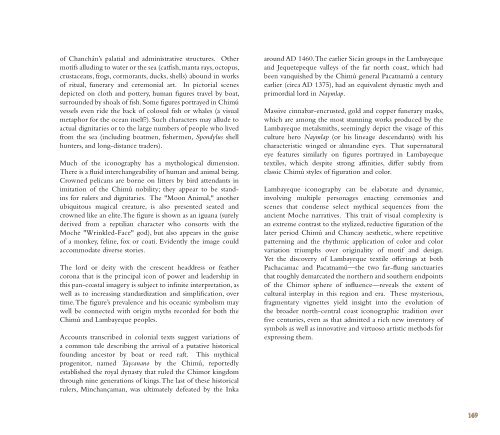Create successful ePaper yourself
Turn your PDF publications into a flip-book with our unique Google optimized e-Paper software.
of Chanchán’s palatial and administrative structures. O<strong>the</strong>r<br />
motifs alluding to water or <strong>the</strong> sea (catfish, manta rays, octopus,<br />
crustaceans, frogs, cormorants, ducks, shells) abound in works<br />
of ritual, funerary and ceremonial art. In pictorial scenes<br />
depicted on cloth and pottery, human figures travel by boat,<br />
surrounded by shoals of fish. Some figures portrayed in Chimú<br />
vessels even ride <strong>the</strong> back of colossal fish or whales (a visual<br />
metaphor for <strong>the</strong> ocean itself?). Such characters may allude to<br />
actual dignitaries or to <strong>the</strong> large numbers of people who lived<br />
from <strong>the</strong> sea (including boatmen, fishermen, Spondylus shell<br />
hunters, and long-distance traders).<br />
Much of <strong>the</strong> iconography has a mythological dimension.<br />
There is a fluid interchangeability of human and animal being.<br />
Crowned pelicans are borne on litters by bird attendants in<br />
imitation of <strong>the</strong> Chimú nobility; <strong>the</strong>y appear to be standins<br />
for rulers and dignitaries. The "Moon <strong>Animal</strong>," ano<strong>the</strong>r<br />
ubiquitous magical creature, is also presented seated and<br />
crowned like an elite. The figure is shown as an iguana (surely<br />
derived from a reptilian character who consorts with <strong>the</strong><br />
Moche "Wrinkled-Face" god), but also appears in <strong>the</strong> guise<br />
of a monkey, feline, fox or coati. Evidently <strong>the</strong> image could<br />
accommodate diverse stories.<br />
The lord or deity with <strong>the</strong> crescent headdress or fea<strong>the</strong>r<br />
corona that is <strong>the</strong> principal icon of power and leadership in<br />
this pan-coastal imagery is subject to infinite interpretation, as<br />
well as to increasing standardization and simplification, over<br />
time. The figure’s prevalence and his oceanic symbolism may<br />
well be connected with origin myths recorded for both <strong>the</strong><br />
Chimú and Lambayeque peoples.<br />
Accounts transcribed in colonial texts suggest variations of<br />
a common tale describing <strong>the</strong> arrival of a putative historical<br />
founding ancestor by boat or reed raft. This mythical<br />
progenitor, named Taycanano by <strong>the</strong> Chimú, reportedly<br />
established <strong>the</strong> royal dynasty that ruled <strong>the</strong> Chimor kingdom<br />
through nine generations of kings. The last of <strong>the</strong>se historical<br />
rulers, Minchançaman, was ultimately defeated by <strong>the</strong> Inka<br />
around AD 1460. The earlier Sicán groups in <strong>the</strong> Lambayeque<br />
and Jequetepeque valleys of <strong>the</strong> far north coast, which had<br />
been vanquished by <strong>the</strong> Chimú general Pacatnamú a century<br />
earlier (circa AD 1375), had an equivalent dynastic myth and<br />
primordial lord in Naymlap.<br />
Massive cinnabar-encrusted, gold and copper funerary masks,<br />
which are among <strong>the</strong> most stunning works produced by <strong>the</strong><br />
Lambayeque metalsmiths, seemingly depict <strong>the</strong> visage of this<br />
culture hero Naymlap (or his lineage descendants) with his<br />
characteristic winged or almandine eyes. That supernatural<br />
eye features similarly on figures portrayed in Lambayeque<br />
textiles, which despite strong affinities, differ subtly from<br />
classic Chimú styles of figuration and color.<br />
Lambayeque iconography can be elaborate and dynamic,<br />
involving multiple personages enacting ceremonies and<br />
scenes that condense select mythical sequences from <strong>the</strong><br />
ancient Moche narratives. This trait of visual complexity is<br />
an extreme contrast to <strong>the</strong> stylized, reductive figuration of <strong>the</strong><br />
later period Chimú and Chancay aes<strong>the</strong>tic, where repetitive<br />
patterning and <strong>the</strong> rhythmic application of color and color<br />
variation triumphs over originality of motif and design.<br />
Yet <strong>the</strong> discovery of Lambayeque textile offerings at both<br />
Pachacamac and Pacatnamú––<strong>the</strong> two far-flung sanctuaries<br />
that roughly demarcated <strong>the</strong> nor<strong>the</strong>rn and sou<strong>the</strong>rn endpoints<br />
of <strong>the</strong> Chimor sphere of influence––reveals <strong>the</strong> extent of<br />
cultural interplay in this region and era. These mysterious,<br />
fragmentary vignettes yield insight into <strong>the</strong> evolution of<br />
<strong>the</strong> broader north-central coast iconographic tradition over<br />
five centuries, even as that admitted a rich new inventory of<br />
symbols as well as innovative and virtuoso artistic methods for<br />
expressing <strong>the</strong>m.<br />
169







